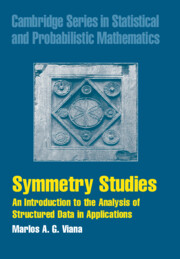Book contents
- Frontmatter
- Contents
- Preface
- 1 Symmetry, Classification, and the Analysis of Structured Data
- 2 Sorting the Labels: Group Actions and Orbits
- 3 Connecting Symmetries and Data: Linear Representations
- 4 Data Reduction and Inference: The Canonical Projections and Their Invariants
- 5 Examples and Techniques
- 6 Symmetry Studies of Short Symbolic Sequences
- 7 Symmetry Studies of Curvature Data
- 8 Symmetry Studies of Planar Chirality
- Appendix A Computing Algorithms
- Appendix B Glossary of Selected Symbols, Notations, and Terms
- Bibliography
- Index
1 - Symmetry, Classification, and the Analysis of Structured Data
Published online by Cambridge University Press: 06 July 2010
- Frontmatter
- Contents
- Preface
- 1 Symmetry, Classification, and the Analysis of Structured Data
- 2 Sorting the Labels: Group Actions and Orbits
- 3 Connecting Symmetries and Data: Linear Representations
- 4 Data Reduction and Inference: The Canonical Projections and Their Invariants
- 5 Examples and Techniques
- 6 Symmetry Studies of Short Symbolic Sequences
- 7 Symmetry Studies of Curvature Data
- 8 Symmetry Studies of Planar Chirality
- Appendix A Computing Algorithms
- Appendix B Glossary of Selected Symbols, Notations, and Terms
- Bibliography
- Index
Summary
Introduction
George Pólya, in his introduction to mathematics and plausible reasoning, observes that
A great part of the naturalist's work is aimed at describing and classifying the objects that he observes. A good classification is important because it reduces the observable variety to relatively few clearly characterized and wellordered types.
Pólya's (1954, p. 88) remark introduces us directly to the practical aspect of partitioning a large number of objects by exploring certain rules of equivalence among them. This is how symmetry will be understood in the present text: as a set of rules with which we may describe certain regularities among experimental objects or concepts. The classification of crystals, for example, is based on the presence of certain symmetries in their molecular framework, which in turn becomes observable by their optical activity and other measurable quantities.
The delicate notion of measuring something on these objects and recording their data is included in the naturalist's methods of description, so that the classification of the objects may imply the classification or partitioning of their corresponding data. Pólya's picture also includes the notion of interpreting, or characterizing, the resulting types of varieties. That is, the naturalist has a better result when he can explain why certain varieties fall into the same type or category.
This chapter is an introduction to the interplay among symmetry, classification, and experimental data, which is the driving motive underlying any symmetry study and is often present in the basic sciences. The purpose here is to demonstrate that principles derived from such interplay often lead to novel ways of looking at data, particularly of planning experiments and, potentially, of facilitating contextual explanation.
- Type
- Chapter
- Information
- Symmetry StudiesAn Introduction to the Analysis of Structured Data in Applications, pp. 1 - 29Publisher: Cambridge University PressPrint publication year: 2008



